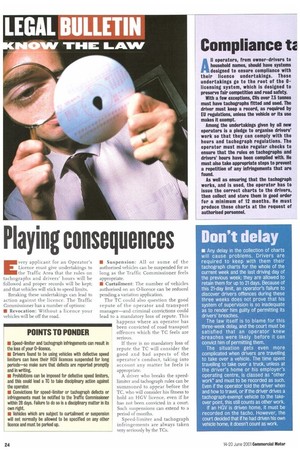Compliance tg planning
Page 24

Page 25

If you've noticed an error in this article please click here to report it so we can fix it.
AII operators, from owner-drivers to household names, should have systems designed to ensure compliance with their licence undertakings. Those undertakings go to the root of the 0licensing system, which is designed to preserve fair competition and road safety.
With a few exceptions, CVs over 7.5 tonnes must have tachographs fitted and used. The driver must keep a record, as required by EU regulations, unless the vehicle or its use makes it exempt.
Among the undertakings given by all new operators is a pledge to organise drivers' work so that they can comply with the hours and tachograph regulations. The operator must make regular checks to ensure that the rules on tachographs and drivers' hours have been complied with. He must also take appropriate steps to prevent a repetition of any infringements that are found.
As well as ensuring that the tachograph works, and is used, the operator has to Issue the correct charts to the drivers, then collect and store them in good order for a minimum of 12 months. He must produce these charts at the request of authorised personnel.
But even if the operator follows these rules, he can still fall foul of the law and the TCs because some offences can be committed without his knowledge. These Include:
ai Failure by the driver to use a tachograph Oard to record activity for all or part of the Working day;
• Failure by the driver to complete the tachograph centrefield details. Other offences in this area include:
• Failure to collect a chart from the driver Without a reasonable excuse within 21 days; 0 Failure to produce a chart when requested by an authorised officer, either at the roadside or at an operating centre; 0 Failure to have the tachograph calibrated it two and six-yearly intervals. The maximum penalty for these offences 15,000. With drivers' hours offences the law is Just as demanding, because when a driver commits an hours offence, the operator who permits or causes the driver to commit that offence also commits an offence. "Permitting" means that the operator failed to take "reasonable steps" to prevent offences by the drivers. The operator must comply with the obligations set out in his
undertaking to the Traffic Area and under the EU regulations.
The court or IC will certainly have to be satisfied that the operator's action or inaction was not wilful or reckless. If, for example, an operator fails to check a driver's charts he will be in breach of his duty to check and prevent infringements, This could amount to recklessness, which would result in a conviction for permitting the driver to infringe the hours rules.
The onus is on the operator to show that he has taken precautions to prevent any infringements, but each case will be assessed on its merits. As the offence of permitting hours offences can be committed by the person who is in a position to control the driver, the transport manager or transport clerk could be charged with permitting. If a traffic clerk's duties include sending charts to an outside agency for analysis and to advise drivers of infringements he could be convicted of permitting—particularly if analysis revealed repeated hours offences and the clerk didn't notify senior management.
Operators are not expected to do the impossible, but they must take reasonable steps to keep their drivers within the law.
































































































